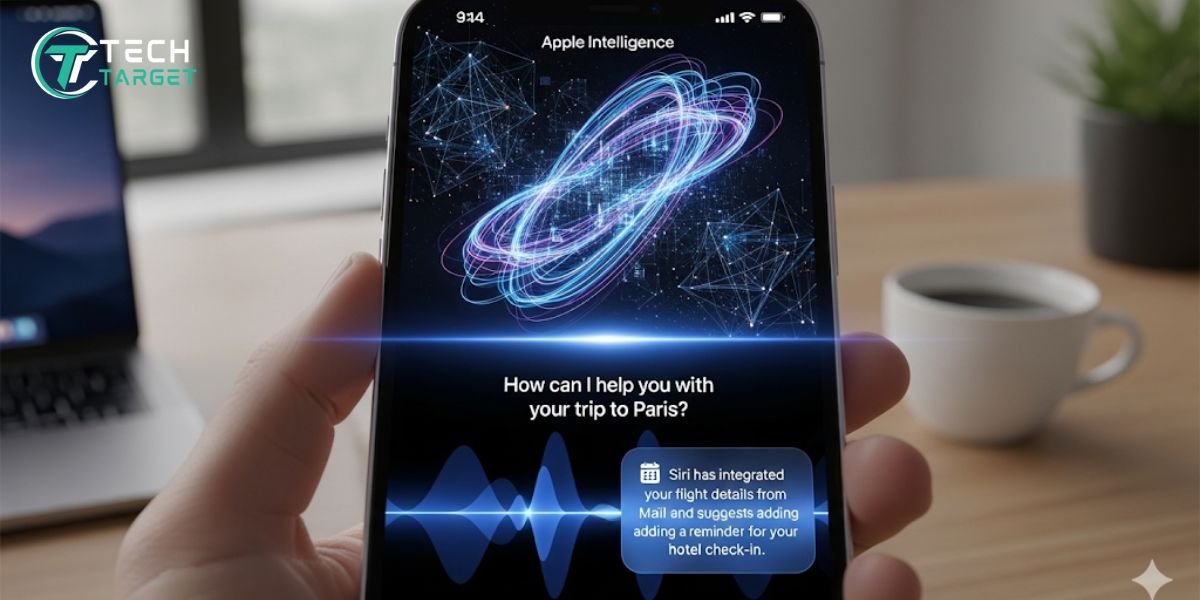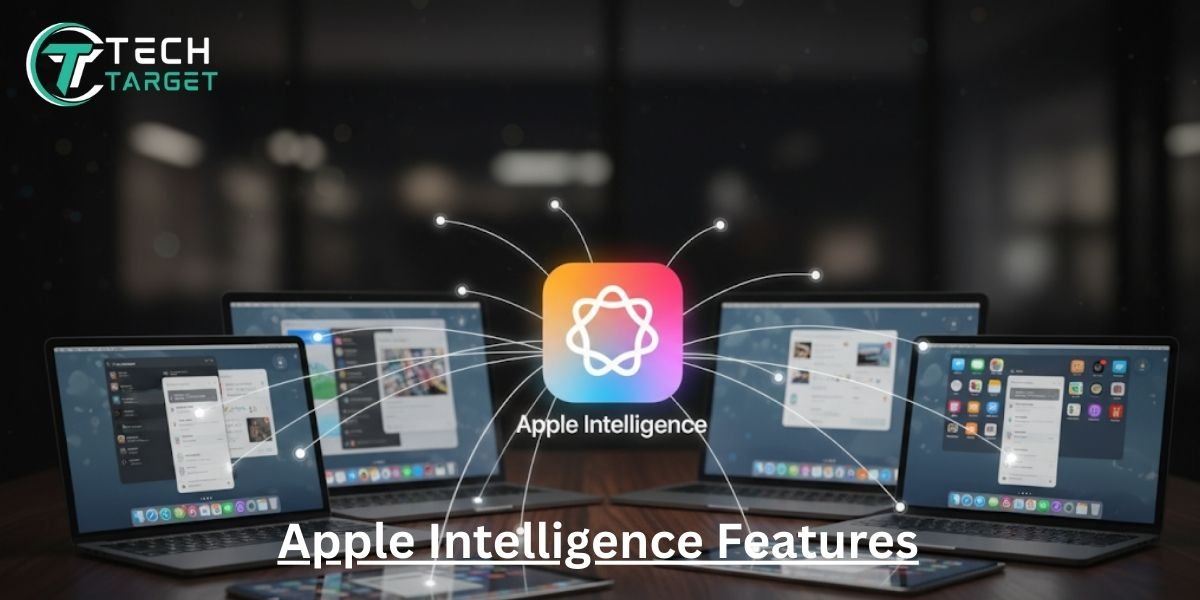What is Apple Intelligence? It’s not just another new app or a chatbot for your device. It is a new system built directly into your iPhone, iPad, and Mac that makes your devices smarter and more personal. Think of it as a helpful assistant that understands you, your conversations, and the information on your device. It uses advanced artificial intelligence (AI) to simplify your daily tasks, help you communicate better, and give you new ways to be creative.
This intelligence works behind the scenes, using what it knows about your day and your conversations to help in the most natural ways. Instead of just answering a question, it can perform actions for you based on what you are doing. The goal of this system is to make your technology truly work for you, all while keeping your personal information private and secure.
Key Takeaways
- On-Device AI: Most of Apple Intelligence’s work happens directly on your device, ensuring your private information stays with you.
- Private Cloud Compute: For bigger tasks, Apple uses a unique, secure, cloud-based solution that is verifiable by outside experts.
- A Smarter Siri: The classic voice assistant is now more capable, natural, and can understand what is on your screen.
- New Writing Tools: The system offers powerful features to help you write better, proofread, and summarize text across many apps.
- Creative Tools: New features like Genmoji and Image Playground give you fun, new ways to create personalized images.
- Developer Access: A new framework allows app creators to use Apple’s powerful on-device models to build their own smart features.
What Is Apple Intelligence?
From my perspective, just knowing the answer to what is Apple Intelligence? isn’t enough—rather, it’s about how it will make your life easier and smarter. It’s a new technology that makes your device more intelligent and creative to help you with your daily tasks.
Apple Intelligence is a suite of intelligent tools that are built into the core of your Apple devices. It uses advanced generative AI models to help you in new and exciting ways. Instead of relying on a distant cloud server for every action, this system is deeply personal. It understands the people you talk to, the events in your calendar, and the messages you get. This helps it give you the right help at the right time.
The most important part of this system is that it’s designed to be on-device first. This means that a lot of the work happens right on your phone or computer, using the powerful Apple-designed chips. This focus on on-device processing is a key part of how the company ensures your privacy and makes your experience fast and responsive.
When Does Apple Intelligence Come Out?
Apple Intelligence made its public debut with the release of iOS 18, iPadOS 18, and macOS Sequoia in September 2024. All features became available with the full public release of these operating systems. This means the apple intelligence release date was a single, worldwide event for all people with a compatible device. The system is available now and will continue to be improved and updated over time with new features.
Who Can Access Apple Intelligence?
Accessing Apple Intelligence requires a device powerful enough to run its advanced features directly on-device. This on-device processing is key to the system’s security and responsiveness. If you’re wondering how to get Apple Intelligence, the process is as simple as updating your device to the latest operating system, as long as you have one of the compatible models listed below.
The system is a free part of the latest software updates and is available on the following devices.
Compatible Devices
iPhone
- iPhone 16 series
- iPhone 15 Pro
- iPhone 15 Pro Max
iPad (with an M1 chip or later)
- All iPad Pro models with M-series chips
- All iPad Air models with M-series chips
Mac (with an M1 chip or later)
- All MacBook Air models with M-series chips
- All MacBook Pro models with M-series chips
- All iMac models with M-series chips
- All Mac mini models with M-series chips
- All Mac Studio models with M-series chips
- All Mac Pro models with M-series chips
How does Apple Intelligence work?
Apple Intelligence works on a mix of on-device and cloud-based processing, all designed with a focus on privacy. Most of your daily tasks, like using Writing Tools or understanding who you’re talking to, happen right on your device. This keeps your personal information and context on your device, as the models are small enough to run locally on the powerful Apple Silicon.
For more complex requests that need significant power, the system uses a technology called Private Cloud Compute (PCC). This securely sends a request to a dedicated server powered by Apple’s own chips. The server does the work and then deletes the data immediately. Crucially, the code on these servers is open for outside security experts to inspect, which helps build a high level of trust and transparency.
Top 9 Features of Apple Intelligence Explained
Apple Intelligence comes with powerful new features that make your devices work for you in a more intelligent way, simplifying your daily tasks.
1. Enhanced Siri
Siri is now much more helpful and natural. It has a new look with a glowing light around the screen’s edges and can understand conversational language better. This means you can talk to Siri without using special keywords or phrases. A major update is the ability to communicate with Siri by simply typing your questions, which is a great option for quiet or public spaces.
The biggest change is Siri’s ability to understand what’s on your screen. For example, if a friend texts you an address, you can say, “Siri, add this address to their contact card,” and it will know exactly what “this address” is. It can also perform actions across apps, like finding a photo you’re looking for by describing it.
2. ChatGPT Integration
Apple Intelligence has a partnership with OpenAI that brings ChatGPT to your devices. This integration is seamless and optional. When a question is too complex for the on-device model, Siri can ask for your permission to send the request to ChatGPT. This gives you the best of both worlds: the personal, on-device power of Apple Intelligence and the vast knowledge of ChatGPT.
The system will always ask for your permission first, so you are in control. It also keeps your information private by hiding your IP address and not using your data to train the model. This makes getting more information from the outside world simple and secure, without needing a separate OpenAI account.
3. Writing Tools
This suite of tools is available in apps all over your iPhone, iPad, and Mac, making it easier to communicate and write. The Rewrite feature lets you select any piece of text and change its tone, whether you want to make it more friendly, professional, or short and to the point. This is perfect for when you need to quickly polish an email or a message.
The Proofread tool checks your text for mistakes and suggests changes, with simple explanations. The Summarize tool can take a long article or document and give you the main points in a short, easy-to-read list. It’s like having a writing assistant ready to help you at any time.
4. Notification Summaries
This feature uses the system’s intelligence to organize your notifications for you. Instead of getting a long list of alerts, the system will group them by importance. It can even show you a short summary of your most urgent or important notifications at the top of your screen, helping you avoid getting overwhelmed.
The system learns what is important to you over time. For example, it can see that a message from your family or a notification about a flight is more important than a new offer from an app. This allows it to prioritize what you need to see first, making your notifications more helpful and less distracting.
5. Smart Reply
In the Messages and Mail apps, the system can read your conversation and suggest a few quick replies. These suggested replies are based on the context of the chat, so they make sense for what you’re talking about. This feature saves you time and effort when you’re in a hurry and just need to send a quick response.
The Smart Reply feature can also identify questions within a message and give you a few options to answer them directly. For example, if someone asks, “Are you free at 7 PM for dinner?” Smart Reply might offer options like “Yes,” “No,” or “I’ll let you know.” This makes replying to messages and emails faster and more efficient.
Here are our blogs on popular webmail services that you may find useful:
| How to Set Up and Access Consolidated Communications Webmail on Any Device | Network Solutions Webmail: Practical Tips and Advanced Features |
| Penteledata Net Webmail Login Errors? Here’s How to Fix It Fast | EarthLink Webmail Complete Guide 2025 – Tech Target |
6. Genmoji
Genmoji is a fun new way to create your own emojis. When you can’t find the perfect emoji to express how you feel, you can simply type a description. For example, you can write “a smiley face wearing a cowboy hat and sunglasses,” and the system will create a new, original emoji just for you. This feature works in real-time and allows for endless creativity in your messages.
What makes Genmoji truly unique is its ability to create emojis based on the people and pets in your photos. You can describe a friend and the system will generate a Genmoji inspired by them. This adds a personal touch to your conversations that goes beyond the standard emoji keyboard.
7. Image Playground
Image Playground is a creative tool that lets you make original images on the spot. It is built directly into apps like Messages, Notes, and Freeform. You can use it to quickly create an image by typing a simple description, or by choosing from different styles like “Animation” or “Illustration.” This is a quick and easy way to add a visual touch to your messages and projects.
The feature is designed for fun and easy use, so you don’t need to be an artist to create something cool. It also lets you use people from your Photos library as a base, allowing you to create images that feature your friends or family. This makes the tool both powerful and personal.
8. Image Wand & Clean Up
Image Wand is a new tool in the Notes app that turns your rough sketches into polished images. All you have to do is circle a drawing with your Apple Pencil, and the system will create a beautiful, finished image in the same style. This helps you quickly turn a rough idea into a clear and polished visual.
The Clean Up tool, found in the Photos app, uses AI solutions to help you remove unwanted objects from your pictures. You just circle an object you don’t want, and the system intelligently removes it without ruining the background. It is a simple and powerful tool for making your photos look their best without complex editing software.
9. Visual Intelligence
This feature helps you learn about things you see on your screen or in the real world. For example, you can take a picture of a plant and ask the system to identify it. It can also analyze the content on your screen. If you see a flyer for a concert, you can simply tap it to create a calendar event or a reminder. This makes it easier to get information and take action based on what you are looking at.
Visual Intelligence is available through a quick button press (like taking a screenshot), which brings up a set of tools. You can use these tools to highlight something on your screen and ask a question about it, or even perform a visual search to find similar items online. This feature turns your phone into a powerful tool for discovering more about the world around you.
How Apple Intelligence Protects Your Data?
Security and privacy are at the heart of Apple Intelligence. The entire system is built on two core principles: on-device processing and verifiability. All personal and contextual data is processed locally on your device, ensuring it never leaves your control.
For more complex tasks, Apple’s Private Cloud Compute (PCC) provides a highly secure, server-based solution. These servers are powered by Apple Silicon and run a custom, verifiable operating system. Critically, data sent to the PCC is never stored or made accessible to Apple. Independent security researchers can inspect the code running on these servers, a move that provides transparency and helps build trust in a way no other company does.
How Developers Can Power Apps with Apple Intelligence?
Apple has given app developers a powerful new way to use its AI system. The Foundation Models framework gives developers direct access to the on-device models at the core of Apple Intelligence. This means developers can build intelligent, private, and offline-capable experiences right into their apps without needing to rely on a big, costly cloud service.
This framework is a huge step forward for the ai apple community because it allows for smart features that work without an internet connection. It also helps developers save money on cloud fees. The tools in this framework are easy to use, allowing for things like creating structured text from the AI or letting the AI call a tool inside an app.
FAQs
What is the primary difference between Apple Intelligence and other AI?
The main difference is its focus on personal context and privacy. It runs on-device as much as possible, and when it needs to use the cloud, it does so through the verifiable and secure Private Cloud Compute system.
When does the update come out?
The update came out in September 2024 as part of iOS 18, iPadOS 18, and macOS Sequoia. If you have a compatible device, you can get the features by updating your software.
Can I use Apple Intelligence on my iPhone 14?
No. You need a device with an Apple A17 Pro chip or newer to use Apple Intelligence. The iPhone 14 does not have the necessary hardware.
Is Apple Intelligence free to use?
Yes, all of the features in Apple Intelligence are free for users who have a device that supports them.
How does Apple Intelligence protect my personal data?
It keeps your data safe by doing most of its work on your device. For tasks that need a lot of power, it uses a secure system where your data is used only for the task and is never stored.
Final Remarks
What is apple intelligence? It is Apple’s plan for a more helpful, personal, and private AI. By building this intelligence directly into the core of its products, Apple has created a system that understands and helps you in your daily life, all while putting your privacy first. This move sets a new standard for how technology can be both smart and secure.











